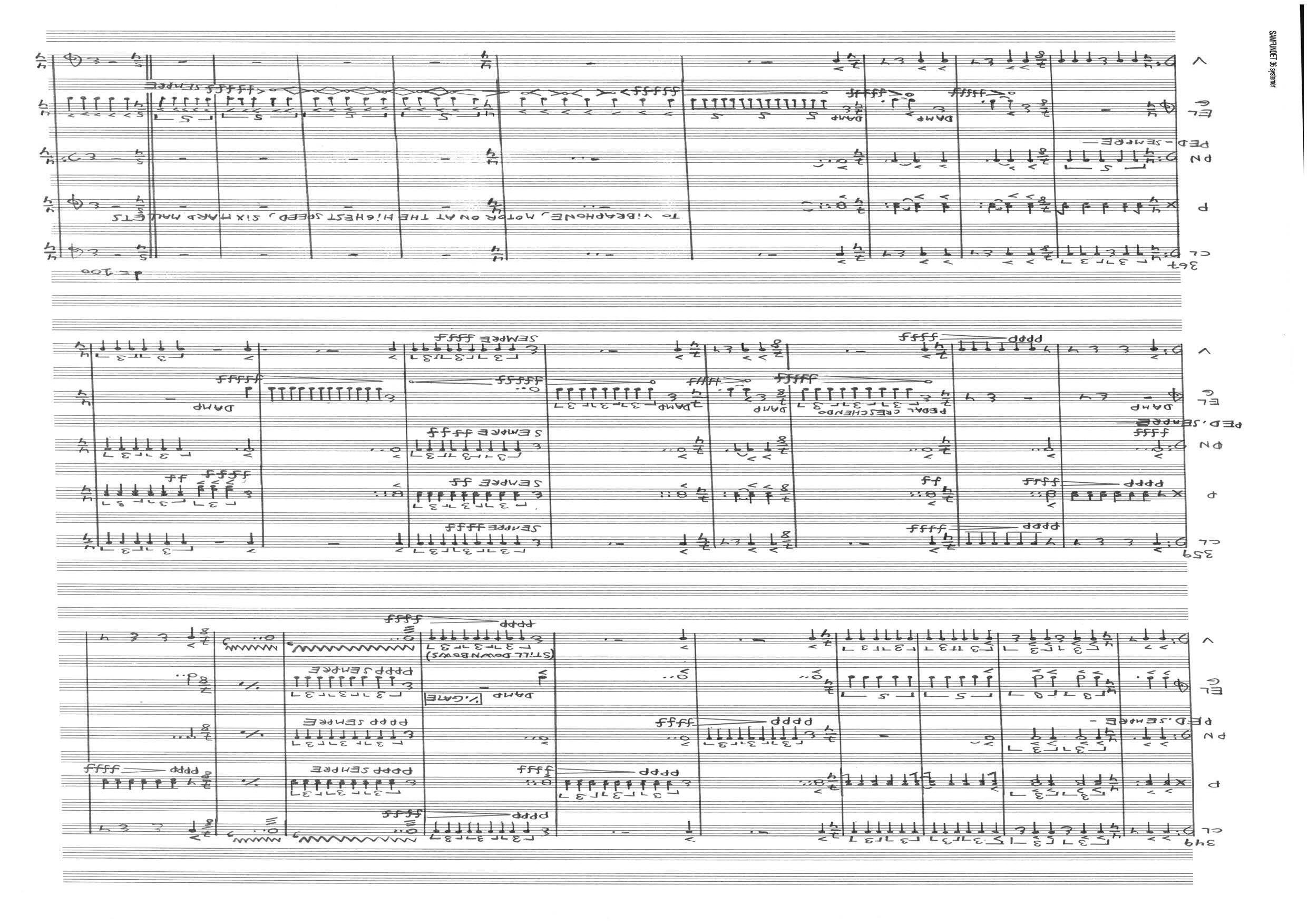Jexper Holmen
LIGE NU ER JEG
GLAD FOR JEG
IKKE ER DIG (2023)
Right now I'm glad I'm not you for clarinet, percussion, prepared piano, electric guitar and amplified violoncello
Dur. 22′
Written for K!ART
SCORE


(2023)
Right now I'm glad I'm not you for clarinet, percussion, prepared piano, electric guitar and amplified violoncello Dur. 22′
PERFORMANCE NOTES
Clarinet
The “constant glissando” should be played with a constant change of pitch without resting on the written pitches.
During long phrases without breaks the clarinet player should ideally circular breathe. Otherwise breathe discretely when needed. The clarinet part is doubled at pitch by the violoncello throughout which will camouflage breaths.
Percussion
The percussion part is written for: Five tom-toms of different pitch Bass drum
Vibraphone with motor

The tom-toms may be substituted with other similar drums depending on availability.
The vibraphone part consists exclusively of five- and six-part chromatic clusters spanning a major third or a perfect fourth. All these can be played with one hand on the “black” bars and the other hand on the “white” bars with three mallets in each hand. (In most of the clusters the “black” hand strike only two bars, but the ones covering a fourth feature three bars in both hands). Use very hard mallets. The instrument’s motor should preferably be set to very fast speed, causing a grotesque flickering effect.
The >>>>>>>>>> sign indicates a heavy tremolo with both hands hitting the bars simultaneously:

ƒƒƒƒ is an orchestral or rock concert like ultra-fortissimo meant to balance only with the electric guitar.
ƒƒ is a chamber music fortissimo meant to balance with the clarinet, piano and cello.
Prepared piano
Preparation: 50 crystal glass marbles (25 mm in diameter) should be distributed over all the strings. When played loud with the pedal down the marbles will cause an abrasive rattling and fizzing sound.
The piano part throughout the piece consists exclusively of chromatic clusters each one played with both hands together. The hands never separate. Each clusters should be as broad as possible. Sometimes only the highest or the lowest note is written. In such instances the meaning is specified in the score.
The >>>>>>>>>> sign indicates a heavy tremolo with both hands hitting the keys simultaneously:

Electric guitar
The instrument should be played through an amplifier placed on stage next to the performer. When playing loudly some natural distortion should occur, but no "artificial" distortion should be added.
Two effects are required:
Gate
Pitch shift, transposing 22 semitones up (an octave plus a minor seventh)
NB: Sections using pitch shift are notated where they should be played. It will sound 22 semitones above what is written. The instrument will sound shrill with this amount of pitch shifting – that is the desired effect, so refrain from applying any filtering.
A volume pedal is also required:
ƒƒƒƒ is an orchestral or rock concert like ultra-fortissimo meant to balance only with the percussionist playing as loud as they can.
ƒƒƒƒƒ is even louder if the amplifier can handle it. This is only used when the guitar plays by itself.
ƒƒ is a chamber music fortissimo meant to balance with the clarinet, piano and cello.
~ above a note indicates an upward pitch bend by twisting the string. The note should be bent as far upward as possible and then back to its starting point. The effect should be a small, quick glissando, that reaches its peak around the midpoint of the note and slides back down to the starting point, before the next note is played:

Amplified cello
The instrument should be amplified through an amplifier placed on stage in front of the performer. The amplified instrument should be roughly as loud as the clarinet. (The cello and clarinet parts double each other at pitch throughout the piece.) These two instruments playing ƒƒƒƒ together should balance with one of the other instruments.
The “constant glissando” should be played with a constant change of pitch without resting on the written pitches.
















